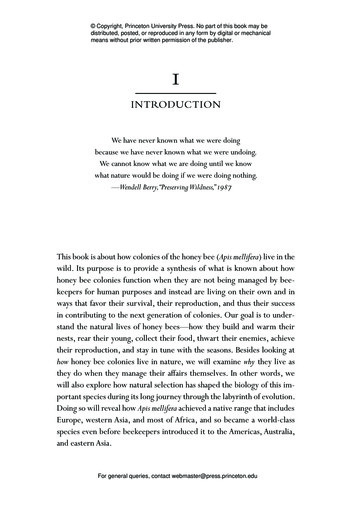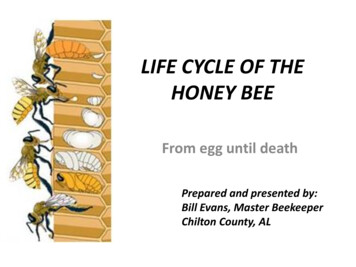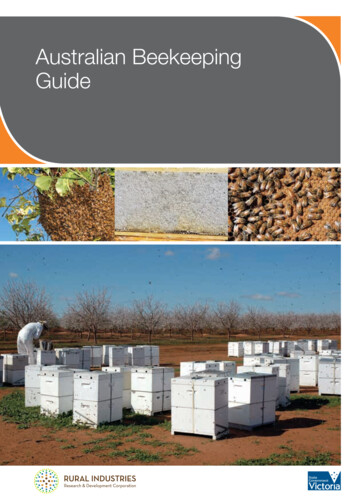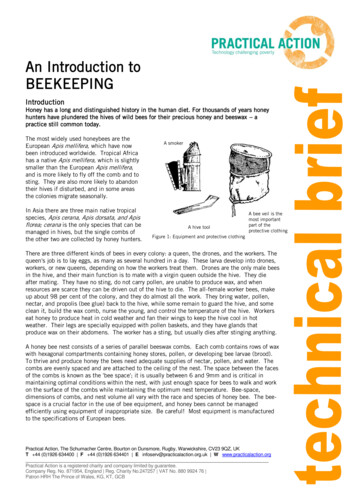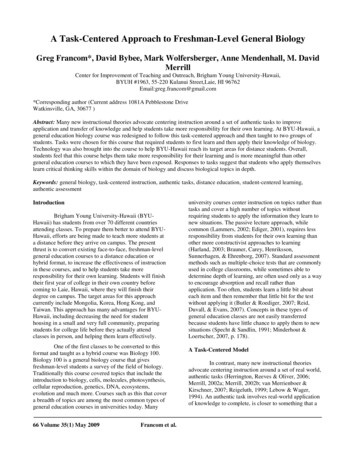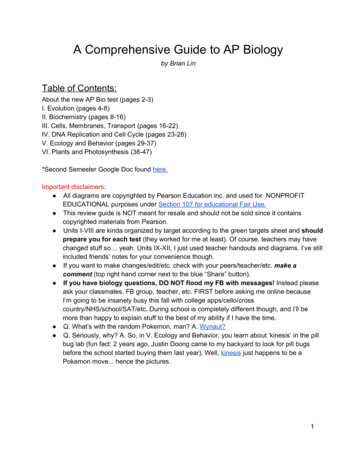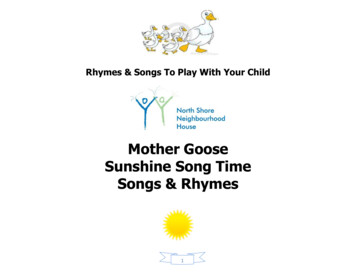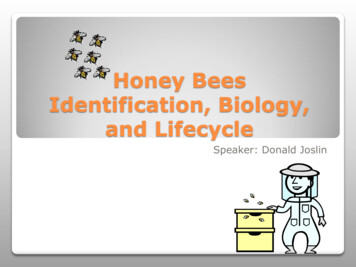
Transcription
Honey BeesIdentification, Biology,and LifecycleSpeaker: Donald Joslin
Hive consists of three types of bees Queen, Drone and Worker
Color:WhiteYellowRedGreenBlueFor YearEnding In:1 or 62 or 73 or 84 or 95 or 0Queen Marking Colors
Queen Only Fertile female in the Hive Can lay 2000 eggs each day She can live 5 years, 3-years average One per colony usually Mates in flight with 7-150 drones
Queen Her thorax is slightly larger No pollen baskets or wax glands Stinger is smoother and curved (and reusable)The Honey Bee Colony
QueenPheromones The “social glue” of the hiveGives the colony its identity and temperamentSends signals to the workers Mates once, in flight, with 7 to 150 drones Lays both fertilized and unfertilized eggs Fertilized eggs become workers or QueensUnfertilized eggs become drones
How does an egg become a queen insteadof a worker? Royal Jelly is fed to the larvae for a muchlonger period of time Royal Jelly is secreted from the hypopharynx ofworker beesRoyal Jelly
Supercedure Cell(Never cut these unlessyou have a replacementqueen ready)
Basic Anatomy
Worker Sterile female Does the work of the hive Have specialized body structures Brood food glands – royal jelly Scent glands (pheromones) Wax glands Pollen baskets Barbed stingers – Ouch!The Honey Bee Colony
WorkerBees Perform Roles Nurse Guard ForagerCastes
Worker bees progress through verydefined growth stages When first hatched they become Nurse Bees Clean cells, keeps brood warm, feed larvae Receive nectar from field bees Cleans the hive Builds wax comb Begin to take orientation flightsNurse Bee
Guard Bees Keep unwanted visitors out of the hiveFan to cool the hiveFan to release locator pheromone (Nasonov)Fan to dehydrate honeyUndertaker Bees Remove the dead
Forager Last stage of lifeGathers nectar and pollenFills nature’s critical pollinator roleLow survival rate Predators Insecticides And if she survives this she Works herself to death!Castes
Laying Worker Sterile female When a colony becomes permanentlyqueenless, the ovaries of several workers beginto develop and workers begin to lay unfertilizedeggs This is normally suppressed by presence ofbrood, the queen and her pheromones The colony is doomed
Drone Fertile male No stinger, pollen baskets, or wax glands Exists solely to mate with queens (then dies) Put out for the winter
Development TimesBEEEGGLARVAPUPAETOTALLIFE SPANQueen35-1/27-1/2162-5 yearsWORKER361221DRONE36-1/214-1/2 246 weeks Inside duties Forager8 weeks
If you see capped swarm cells the oldqueen and her forager bees are gone! Or will be shortly If your hive is nasty There may not be a queen Or, you need to Requeen ( genetics)Using Your Knowledge
Probably the single most distinguishingcharacteristic of the honey bee They are social They communicate via pheromones anddancing The forager bee dances to tell the otherforagers where the source of nectar or pollen isCommunication
Beekeeping Equipment
Honey BeeDiseases and Pests
Thereare two categories ofdiseases that concern us Brood diseases Adult diseases Pests includeMites, Mice, Hive beetle, Wax Moth,Skunks and Bears!
AmericanFoulbrood (devastating) European Foulbrood (least likely) Chalkbrood Theseare the most likely occurringbrood diseases we will encounterBrood Diseases
Caused by spore forming bacteriumThe most destructiveAttacks brood, does not affect adult beesLarvae eats spores and dies after cappingCells are discolored, sunken and havepunctured cappingsColonies must be burned or irradiatedLarvae Die after CappingAmerican Foulbrood
The spores are very difficult to eradicate Don’t buy used equipment Even honey may contain AFB spores Burning is required by law! Irradiation is becoming accepted(Worcester Beekeepers IrradiationProgram) American Foulbrood
Often considered a "stress" diseaseMost prevalent in the SpringA healthy colony can usually surviveHygienic Bees quickly recoverLarvae die before cappingEuropean Foulbrood
Fungal brood disease caused by sporeforming fungusAffects all brood typesDead larvae are chalky white and fluffyPrevalent in late springIncreasing ventilation helps recoveryStrong bee populations can deal with itand not be destroyed by the infectionChalkbrood
Nosema Nosema Ceranae Deformed Wing Virus Acute Paralysis Virus Kashmir Bee Virus Adult Diseases
Single Cell Protozoan Two Stages Long Lived Spore Vegetative Form - the growing stage Diagnosis Spotting on hiveField gut testSlow/sluggish hiveNosema
Dysentery From too much indigestible matter Occurs during colder months Lack of Cleansing Flights ChilledBrood Brood dying from sudden coldsnaps Only inspect on warm days 65
BearsSkunksMiceSmall Hive BeetleWax MothTracheal MiteVarroa MiteHoney Bee Pests
From South AfricaFirst discovered in Charlestown S.C. 1996By 1999 found in California, Maine, Iowa,Minnesota, Massachusetts, Texas, andothersLarvae hatch eating honey and pollenLeave hive and Pupate in the groundLarvae are not Light SensitiveSmall Hive Beetle
Not a big problem - so farCold winters kill mostOil Traps in HiveCheckmite Plus CoumafousGardstar – Soil DrenchDiatomaceous earth – acts as desiccant insoilTreatment for SHB
Lays eggs in brood combLarvae eat castings left by pupaeSpin Strong Silken web consuming thecombStrong hives easily control mothsFreezing temperatures kill eggsPara-moth used for storing combWax Moth
Nearly wiped out British Honey BeesAcarapis Woodi invaded U.S. 1984Mites reproduce in trachea feeding onbloodWeaken and shorten life of beesHighest infestation in winterSome bees more susceptible than othersTracheal Mite
Menthol Crystals Grease Patties Formic Acid – Mite Away Pads Thymol – Apiguard Buy Resistant Bees - BuckfastTracheal Mite Treatments
1987 Discovered in U.S.Reproduce in cell feeding on larvaeTransmits Deformed Wing Virus and AcuteParalysis VirusPrefer Drone broodHigh mite population in summer causeshive to crash when mites switch to workerbrood in the fallVarroa Destructor
Varroa destructor – nymphsand adults
Female enters cell before capping andstarts feeding on pupaeLays a male egg 60 hours laterLays a female egg 30 hour intervalsBrother and sisters MateEmerge with bee and seek new hostVarroa Life Cycle
Apistan – Fluvalinate – Mites are resistantCheckmite – CoumaphousApiguard – ThymolApi Life - VAR- Menthol, Eucalyptus, andThymolMite Away Quick Strip (MAQS) – Formic AcidVarroa Treatments
Queen Marking Colors Color: For Year Ending In: White 1 or 6 Yellow 2 or 7 Red 3 or 8 Green 4 or 9 Blue 5 or 0. Queen Only Fertile female in the Hive Can lay 2000 eggs each day She can live 5 years, 3-years average O
